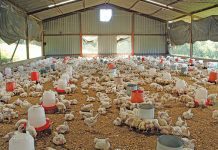
Livestock requires both adequate and accessible water supply at all times. In other words, there should always be enough water for them to drink, and they should be able to get to it easily and regularly.
I have come across communal farming areas where there are hundreds of hectares of grazing without any drinking water at all! This means that the animals have to walk long distances and expend a lot of energy to find water, or else they have to wait until they are kraaled at night before drinking their first water for many hours. This can harm their physical condition and productivity, and even cause serious health problems.
Why do animals need water?
Animals (including humans!) need water for many reasons. Water helps to create saliva that, in turn, assists the animal to chew and digest dry matter.
Water ensures healthy joints, aids the nervous system, helps with hearing and plays a role in vision. It is crucial for important biological chemical processes such as metabolism and the production of energy. Clean, good-quality water helps to regulate body temperature, and plays key roles in growth and reproduction. Survival is impossible without water.
Water storage
When you plan the grazing of your herd, you need to work out the size and positioning of your water storage facilities. This will be governed by the size and composition of your herd. Use the following to plan how much water you’ll need.
The daily water requirements of cattle when the temperature is about 32°C:
- A calf or a young bull/heifer weighing about 270kg needs about 48ℓ of water.
- A cow weighing about 410kg will require about 68ℓ. A lactating cow may need much more.
- A bull weighing about 725kg will require about 78ℓ.
- When the temperature is lower than 32°C, the cattle will require less water than this.
- When the temperature is higher than 32°C and the cattle are on concentrated feed, they may require considerably more water.
Bearing all this in mind, what water storage solutions are best, and where should you install them? Your options include reservoirs, plastic holding tanks and ground dams.
The holding capacity of drinking troughs is also important. For example, 30 big cows in a feedlot system will consume at least 2 000ℓ of water daily, probably closer to 3 000ℓ. You should therefore install a cattle-type drinking trough (holding 400ℓ or more) rather than a sheep-type trough (holding about 150ℓ).
If your cattle are grazing in camps or on the open veld, and there are many of them, carefully calculate the herd’s water requirements and consider having a reservoir that can hold more than 20 000ℓ. If this is not possible, install large plastic holding tanks that total about 20 000ℓ litres or more.
Appoint water monitors to ensure that the levels of your water tanks and reservoirs never drop below 50%, because if you experience any problems with your pumps or pipes, your herd may be in trouble. If the water tanks and reservoirs frequently drop below this threshold, you need more storage capacity.
Water points
A large camp of about 100ha should have at least two watering facilities, one at each end of the area. The more watering points there are, the smaller each holding facility needs to be.
No matter how small the camp, it should have a drinking facility. It is crucial to keep the pumps and pipes in good working order and monitor the inlets to make sure that water flows in properly.
Water quality
It’s not only quantity that counts, but quality. If the water seems discoloured (other than being muddy in earth dams), laden with sediment, or tastes very salty, have it tested. If it is at all unsuitable for the animals, you may have to find a better water source.
If you are using good grazing supplements and the condition of your cattle doesn’t seem to improve, the problem might be a high nitrate level in the water, or highly acidic water.
Clean the water troughs and holding facilities regularly to remove excess algae, as excess plant matter can result in toxin build-up. For the same reason, desilt the dams and inlet furrows when these facilities are empty.
Shane Brody is involved in an outreach programme aimed at transferring skills to communal farmers.













